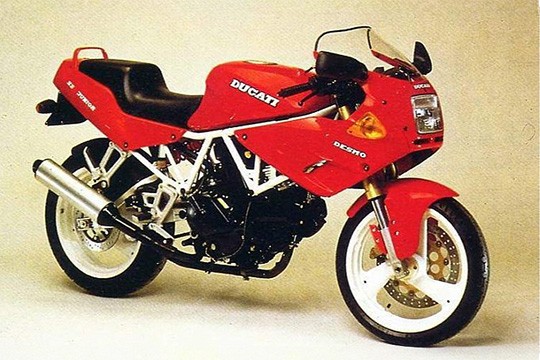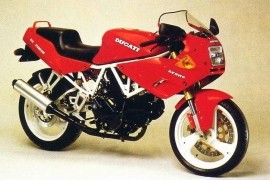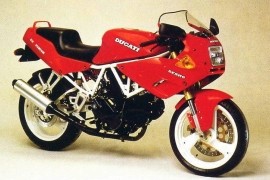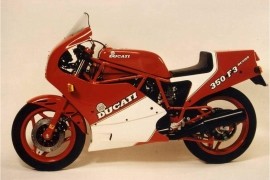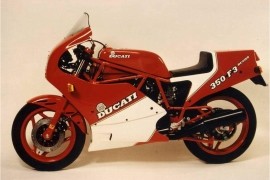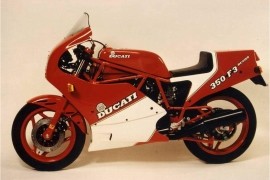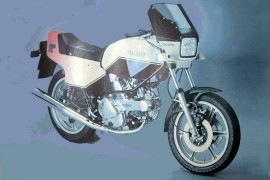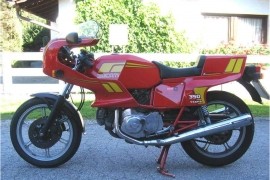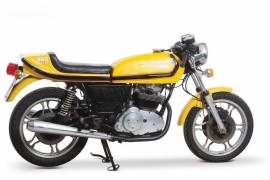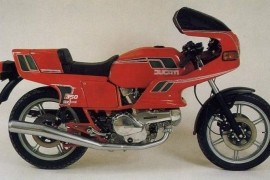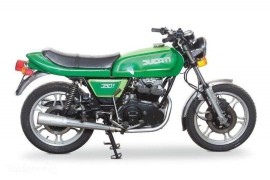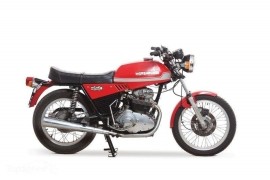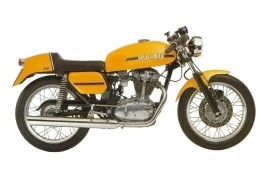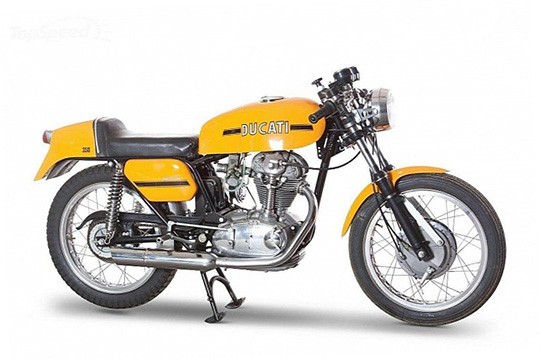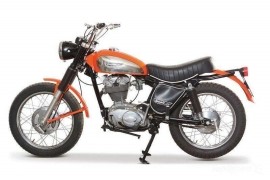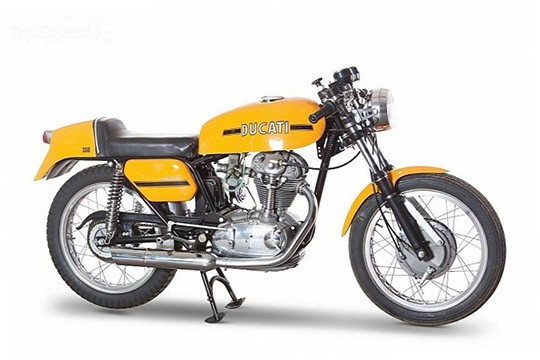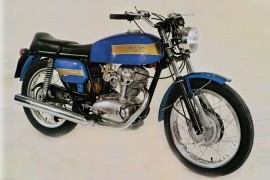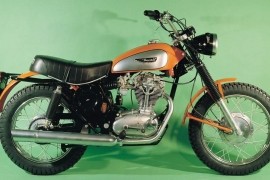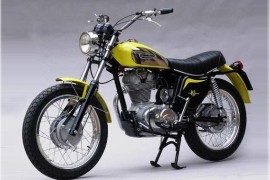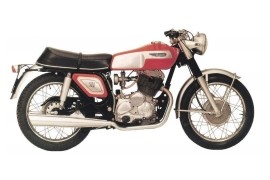DUCATI 350 Models/Series Timeline, Specifications & Photos
First production year: 1968
The Ducati 350SS sports motorcycle was part of the smaller displacement Supersport series in Ducati's range. The bike was first seen in 1991 and was intended for the Italian and Japanese markets. It was produced for only two years until 1993.
The Ducati 350SS and 400SS models were manufactured to meet Japan's (400cc) and Italy's (350cc) driving license schemes of the maximum displacement allowed for beginner motorcyclists. The larger 600SS model was developed as a cheap way to spread Ducati's range.
In 1993, the Italian motorcycle maker released the Ducati 350SS, a sports motorcycle with the same technical, visual, and performance specifications as previous models without modifications or improvements.
It also packed the same standard features, such as an upper fairing with a square headlight, a medium-sized windscreen, a one-piece dual seat with a passenger grab handle, a two-into-one exhaust system, and three-spoke lightweight aluminum wheels.
As for the power figures, the 1993 Ducati 350SS had its heartbeat set by a 349cc four-stroke air-cooled V-twin engine fed by a Mikuni carburetor, delivering an output power of 36 hp with a maximum peak force at 10,500 rpm.
The bike engine was married to a six-speed manual transmission controlled by a wet multi-disc clutch. The power was moved to the rear end via a chain drive, pushing the motorcycle to a top speed of 180 kph (112 mph).
In 1992, the Italian motorcycle manufacturer launched the Ducati 350SS, a sports motorcycle that debuted in 1991. It was in its second year of production and came with the same package as the previous model without any significant modifications or improvements.
It was a sports motorcycle part of the Supersport series in Ducati's range that debuted in 1991 and was intended for the Italian and Japanese markets. It was produced for only two years until 1993.
The bike packed standard features, such as three-spoke lightweight aluminum wheels, a two-into-one exhaust system with a silencer on the right side, a one-piece dual seat with a pillion grab rail, an upper fairing with a rectangular headlight, and a medium-sized windscreen.
The bike was built around a steel trellis frame with a 41 mm Showa inverted fork on the front and an adjustable shock absorber on the rear, delivering optimum suspension performance and handling capabilities.
The bike rolled on 17-inch three-spoke wheels fitted with a 320 mm disc on the front coupled to four-piston calipers and a 245 mm disc on the rear with a dual-piston caliper, offering excellent stopping performance.
In the performance department, the 1992 Ducati 350SS had installed a 349cc four-stroke V-twin air-cooled engine underneath its fuel tank, boasting 36 hp with a peak force at 10,500 rpm.
The Ducati 350SS was a sports motorcycle part of the Supersport series in Ducati's range. The bike debuted in 1991 and was intended for the Italian and Japanese markets. It was produced for only two years until 1993.
It was part of the smaller displacement series that also comprised the 400SS and 600SS models. The Ducati 400SS was manufactured from 1989 to 1997, and the larger 600SS was manufactured from 1993 to 1999.
The Ducati 350SS and 400SS were manufactured to meet Japan's (400cc) and Italy's (350cc) driving license schemes of the maximum displacement allowed for beginner motorcyclists. The larger 600SS model was developed as a cheap way to spread Ducati's range.
In 1991, the Italian motorcycle manufacturer launched the Ducati 350SS, a sports machine made for the Italian and Japanese markets. The 350SS was the smallest in the small displacement series in Ducati's range.
The bike's visual department was characterized by standard features, such as an upper fairing with a square headlight, a medium-sized windscreen, a one-piece dual seat with a passenger grab handle, a two-into-one exhaust system, and three-spoke lightweight aluminum wheels.
As for power, the 1991 Ducati 350SS had its soul brought to life by a 349cc four-stroke V-twin air-cooled engine mounted underneath the fuel tank, delivering 36 hp with maximum strength at 10,500 rpm.
The Ducati F3 was a sports motorcycle manufactured by Ducati from 1985 to 1987. The Ducati 350 F3 was released in 1985 and was available only for the Japanese and Italian markets. Total production was around 1,276 units.
In addition, a 400cc version was produced only for the Japanese market, where the law encourages the use of small displacement motorcycles. However, several 400 F3 models were sold in the British market.
In 1987, the Italian motorcycle manufacturer launched the Ducati 350 F3 Desmo, a sports machine in its third year of production. The bike packed the same specifications as previous models without any significant modifications or improvements.
The bike's visual appearance was represented by standard features, such as a full fairing with a rectangular headlight, a medium-sized windscreen, a single seat, a single exhaust system with a muffler on the left side, and three-spoke lightweight aluminum wheels.
As for the power figures, the 1987 Ducati 350 F3 Desmohad installed a 349cc four-stroke V-twin air-cooled engine underneath its fairing, delivering 42 hp at 9,700 rpm and 33 Nm (24 lb-ft) torque at 7,100 rpm.
The engine was tied to a five-speed gearbox with a manual wet multi-plate clutch that spun the rear wheel via a chain drive, pushing the motorcycle to 178 kph (111 mph).
From top speed to a complete stop, the bike relied on two 260 mm discs on the front wheel and a 260 mm disc on the rear wheel, delivering optimum stopping performance.
In 1986, the Italian motorcycle maker released the Ducati 350 F3 Desmo, a sports motorcycle in its second year of production, wearing the same technical, performance, and visual specifications as the previous model without any modifications or improvements.
The Ducati F3 was a sports motorcycle produced by Ducati between 1985 to 1987. The Ducati 350 F3 was released in 1985 and was available only for the Japanese and Italian markets. Total production was around 1,276 units.
In the visual department, the bike was equipped with standard features, including a full fairing with a medium-sized windscreen, a single seat, a red-finished steel trellis frame, a single exhaust system with a muffler mounted on the left side, and red three-spoke aluminum wheels.
The power was achieved by a 349cc four-stroke V-twin air-cooled engine at its core, fed by two Dell'Orto carburetors, boasting 42 hp with a peak force at 9,700 rpm and 33 Nm (24 lb-ft) torque at 7,100 rpm.
Suspension-wise, the 1986 Ducati 350 F3 Desmo packed a 35 mm Marzocchi telescopic fork on the front and a swingarm tied to a Boge shock absorber on the rear, delivering optimum suspension performance and handling capabilities.
As for the braking performance, the bike's wheels were fitted with two 260 mm discs on the front and a 260 mm disc on the rear, coupled to hydraulic calipers, delivering optimum stopping performance.
The Ducati F3 was a sports motorcycle manufactured by Ducati from 1985 to 1987. The Ducati 350 F3 was released in 1985 and was available only for the Japanese and Italian markets. Total production was around 1,276 units.
In addition, a 400cc version was produced only for the Japanese market, where the law encourages the use of small displacement motorcycles. However, several 400 F3 models were sold in the British market.
In 1985, the Italian motorcycle manufacturer released the Ducati 350 F3 Desmo, a light and agile motorcycle best suited for the youngest and less experienced motorcyclists. As its name says, the bike featured a desmodromic valve system.
Aesthetically, the bike packed features, such as a full fairing finished in red and white, a red-finished trellis frame, a medium-sized windscreen, a single seat, a single exhaust system with a silencer on the left side, and three-spoke aluminum wheels.
Holding the engine, a steel trellis frame also offered mounting points for a 35 mm Marzocchi telescopic fork on the front and a swingarm coupled to a Boge shock absorber on the rear, delivering optimum suspension performance and handling capabilities.
The bike's 18-inch wheels were fitted with two 260 mm discs on the front and a 260 mm disc on the rear, coupled to hydraulic calipers, delivering optimum stopping performance.
As for power, the 1985 Ducati 350 F3 Desmo had installed a 349cc four-stroke V-twin air-cooled engine at its core, fed by two Dell'Orto carburetors, boasting 42 hp at 9,700 rpm and 33 Nm (24 lb-ft) torque at 7,100 rpm.
The 1983 Ducati 350XL Pantah has been designed especially for the Italian market as a bored-down version of the 500 SL. It had features such as a small, nose-fairing with a windscreen, an analogue instrumentation panel, cast-aluminium wheels, a chromed dual exhaust system, Brembo brakes both in the front and in the rear, a dual seat, a telescopic front fork coupled to dual shocks in the rear and a square headlight. In the engine department it sports an air-cooled, four-stroke, 349cc, 90-degree V-Twin powerplant mated to a five-speed manual transmission.
The 1983 Ducati 350SL Pantah has, at its heart, an air-cooled, four-stroke, 349cc, 90-degree V-Twin powerhouse paired to a five-speed manual transmission. Also, it boasts standard features such as a chromed, dual exhaust system, a half-fairing, a single seat, cast-aluminium wheels, dual front disc brakes, a telescopic front fork coupled to dual shock absorbers in the rear, an analogue instrument cluster, and a steel frame.
The Ducati Parallel Twins was a series of standard motorcycles manufactured by Ducati from 1975 to 1977. The twins were produced in several versions, including 350 and 500GTL, 350 and 500 Sport Desmo, and 350 and 500GTV.
In 1979, the Italian motorcycle manufacturer launched the Ducati 350 Sport Desmo, a standard motorcycle that debuted in 1977. It was in its third year of production and packed the same technical, visual, and performance specifications as previous models without modifications or improvements.
The motorcycle packed standard features, such as a single seat, a round headlight with analog instruments mounted on top, a dual exhaust system with a silencer on each side, side-mounted rear shocks, and wire-spoke wheels.
The motorcycle was produced around a down-tube tubular steel frame with a 35 mm Paioli fork on the front and a swingarm tied to dual Marzocchi three-position adjustable shock absorbers on the rear, providing optimum suspension.
From the factory, the bike rolled on 18-inch wire-spoke wheels fitted with two 256 mm Brembo discs on the front and a 257 mm Brembo disc on the rear, acting as stopping power.
As for power, the 1979 Ducati 350 Sport Desmo had installed a 350cc four-stroke air-cooled engine underneath its fuel tank, delivering an output power of 42 hp with maximum strength at 8,500 rpm.
In 1977, the Italian motorcycle manufacturer launched the Ducati 350 Sport Desmo, a smaller version of the 500 Sport Desmo manufactured in 1976. Most Sport Desmo motorcycles were manufactured at the Italjet factory, with engines supplied by Ducati.
When Franco Zaiubouri replaced De Eccher as Ducati's General Manager in September 1975, he wanted to revive the brand by developing a new model to make the twins more attractive to buyers. That is when the Ducati 500 Sport Desmo was planned.
The bike packed standard features in the visual department, such as six-spoke aluminum wheels, a dual exhaust system with a muffler on each side, a single seat, a large, round headlight up front, and a low handlebar.
The bike was built around a down-tube tubular steel frame with a 35 mm Paioli telescopic fork on the front and a swingarm coupled to twin Marzocchi three-way-adjustable shock absorbers on the rear, providing optimum handling capabilities.
The bike rolled on 18-inch wheels fitted with a 256 mm Brembo disc on the front and a 257 mm Brembo disc on the rear, offering excellent stopping power.
As for the power figures, the 1977 Ducati 350 Sport Desmo had its heartbeat set by a 350cc four-stroke air-cooled parallel-twin engine with two Dell'Orto carburetors in charge, delivering 42 hp with maximum strength at 8,500 rpm.
The Ducati Parallel Twins was a series of standard motorcycles powered by 350cc and 500cc engines. The bikes were manufactured between 1975 and 1981 and were powered by parallel-twin engines.
The bike was made in several versions, including the Ducati 350GTL and 500GTL, 350 Sport Desmo and 500 Sport Desmo, and 350GTV and 500GTV. Besides their different displacement, the bikes were slightly different in the visual and technical departments.
In 1997, the Italian motorcycle manufacturer launched the Ducati 350GTV, which was essentially a Desmo model with a GTL engine fitted on it. In addition to the engine, the bike packed Japanese switchgear, a Bosch headlight, a touring handlebar, and a chromed exhaust system.
The bike was built around a steel frame with a 35 mm Paioli fork on the front and twin Marzocchi three-position-adjustable shock absorbers on the rear, providing optimum suspension performance and handling capabilities.
In the braking department, the bike packed two 256 mm Brembo discs on the front wheel and a 257 mm disc on the rear wheel, delivering excellent braking performance.
As for the power figures, the 1977 Ducati 350GTV had installed a 350cc four-stroke parallel-twin air-cooled engine underneath its fuel tank, fed by two Dell'Orto carburetors, boasting 24 hp with a maximum peak force at 7,500 rpm.
The bike was set in motion by a five-speed manual transmission with a wet multi-plate clutch that sent the power to the rear wheel through a final chain drive.
The Ducati Parallel Twins was a series of 350cc and 500cc standard motorcycles manufactured by Ducati from 1975 to 1977. The bikes were powered by a parallel-twin SOHC engine.
In 1975, the Italian motorcycle manufacturer launched the Ducati 350GTL, a motorcycle part of the GTL series designed by Giorgetto Giugiaro, who used the same angular design as the Ducati 860GT model.
The bike's visual department was represented by features such as wire-spoke wheels, a one-piece dual seat with a pillion strap, a round headlight with analog instruments mounted on top, a dual exhaust system with a silencer on each side, and side-mounted rear shocks.
Besides insignificant modifications such as headlight brackets, the Ducati 350GTL remained unchanged throughout its production period.
The bike was built around a steel frame that used the engine as a stressed member, also providing mounting points for a 35 mm Marzocchi fork on the front and three-way adjustable Marzocchi shocks on the rear.
The braking performance was achieved by a single 256 mm Brembo disc on the front wheel and a 160 mm drum braking unit on the rear wheel, offering optimum stopping performance.
As for the power figures, the 1975 Ducati 350GTL had its soul brought to life by a 350cc four-stroke parallel-twin air-cooled engine fed by two Dell'Orto carburetors, delivering an output power of 24 hp at 7,500 rpm.
In 1974, the Italian bike maker released the Ducati 350 Desmo, a standard motorcycle in its fourth year of production, packing almost the same technical, visual, and performance specifications as previous models.
The Ducati 350 Desmo had its last revision in 1973 when it gained several modifications, such as a metal fuel tank, different side panels, a combined seat, a rear mudguard, and the yellow and black color scheme of the larger 750S model. In 1974, the bike received a Ceriani front fork and a 280 mm Brembo brake disc on the front.
The Ducati 350 Desmo was based on the Ducati Mark 3, a standard motorcycle manufactured by Ducati from 1968 to 1974 as a replacement for the Ducati Sebring. It was powered by a 340cc single-cylinder bevel drive SOHC engine.
The 1974 350 Demso had standard features, such as a single exhaust system with the muffler mounted on the right side, side-mounted rear shocks, a single seat, a low handlebar, a round headlight up front, and wire-spoke wheels.
In the performance department, the 1974 Ducati 350 Desmo had fitted a 340cc four-stroke air-cooled single-cylinder engine fed by a Dell'Orto carburetor, delivering 34 hp with maximum peak force at 8,500 rpm.
As for the stopping power, the bike's 18-inch wire-spoke wheels were fitted with a 280 mm disc on the front and a 160 drum unit on the rear, improving braking performance compared to previous models.
In 1972, the Italian motorcycle manufacturer released the Ducati 350 Desmo, a standard motorcycle in its second year of production with the same package as the previous model, packing the same technical, visual, and performance specifications without any modifications.
It was based on the Ducati Mark 3, a standard motorcycle manufactured by Ducati from 1968 to 1974 as a replacement for the Ducati Sebring. It was powered by a 340cc single-cylinder bevel drive SOHC engine.
In 1971, the base Mark 3 and Mark 3D diverged, and the 3D model changed to 350 Desmo. It featured a cafe racer style, fitted with a clip-on handlebar, fiberglass fuel tank, and monoposto seat.
The 1972 Desmo model had standard features, such as wire-spoke wheels, a center stand, a single exhaust system with a silencer on the right side, dual rear shocks, a monoposto seat, and a round headlight up front.
The bike's suspension system comprised a 35 mm Marzocchi telescopic fork on the front and a swingarm backed up by two three-way-adjustable Marzocchi shocks on the rear, providing optimum suspension performance.
As for power, the 1972 Ducati 350 Desmo had its heartbeat set by a 340cc four-stroke air-cooled single-cylinder engine managed by a Dell'Orto carburetor, delivering 34 hp with maximum peak force at 8,500 rpm.
In 1972, the Italian motorcycle manufacturer launched the Ducati 350 Scrambler, a middle-weight motorcycle that debuted in 1968, packing the same specifications as previous models without any significant modifications.
The Ducati 350 Scrambler was an on/off-road motorcycle made by Ducati between 1968 and 1974. It was known in the American market as the Ducati 300SS and in the European market as the Ducati 350SCR.
When released, it was Ducati's first wide-case single-cylinder motorcycle and was intended for the American market. In addition, the model was manufactured under license by Moto Trans in Spain from 1974 to 1976. The total production of the motorcycle was around 11,500 units.
The 1972 model was equipped with factory-installed features, such as a two-piece dual seat with a pillion grab strap, a single exhaust system with the silencer mounted on the right side, a round headlight up front, a center stand, and wire-spoke wheels.
The bike's front end was handled by a 35 mm Marzocchi telescopic fork for suspension and a 180 mm drum unit for braking. The rear end was driven by two Marzocchi shocks for suspension and a 160 mm drum unit for stopping.
As for the power figures, the 1972 Ducati 350 Scrambler had installed a 340cc four-stroke single-cylinder air-cooled engine at its core, delivering an output power of 24 hp with a peak force at 8,500 rpm.
The Ducati Mark 3 was a standard motorcycle manufactured by Ducati from 1968 to 1974. The bike replaced the Ducati Sebring and was powered by a 340cc single-cylinder bevel drive SOHC engine.
Alongside the Mark 3 model, the manufacturer made a higher specification model available under the Mark 3D designation. The new model was fitted with a different head derived from the 350SCD model and used desmodromic valves.
Besides its desmodromic system, the engine was shared with the basic model as well as the cycle parts. The Mark 3D model had several options, including a race kit, a megaphone muffler, and a fairing.
In 1971, the base Mark 3 and Mark 3D diverged, the 3D model changing its name to 350 Desmo and packing a cafe racer style. In addition, the bike was fitted with a clip-on handlebar, a fiberglass fuel tank, and a monoposto seat.
In the performance department, the 1971 Ducati 350 Desmo had its soul brought to life by a 340cc four-stroke single-cylinder air-cooled engine managed by a Dell'Orto carburetor delivering 34 hp with maximum strength at 8,500 rpm.
The bike's engine was married to a five-speed transmission with a manual wet multi-plate clutch, sending power to the rear wheel via a final chain drive, pushing the motorcycle to a top speed of 170 kph (106 mph).
The Ducati Mark 3 was a standard motorcycle produced by Ducati between 1968 and 1974. It was a replacement model for the Ducati Sebring and powered by a 340cc single-cylinder bevel drive SOHC engine.
In addition to the base model, the maker produced a higher specification model available wearing the Mark 3D designation. It packed a different head derived from the 350SCD model, using desmodromic valves.
In 1971, the Italian motorcycle manufacturer released the Ducati Mark 3D, which packed the same engine as the base model but with desmodromic valves and shared its cycle parts. It was also available with optional features, such as a race kit, a fairing, and a megaphone silencer.
In the visual department, the bike packed features such as a round headlight up front with analog instruments mounted on top, a one-piece dual seat with a passenger strap belt, dual, side-mounted rear shocks, a single exhaust system mounted on the right side, and lightweight wire-spoke wheels.
As for the power figures, the 1971 Ducati Mark 3D had installed a 340cc four-stroke single-cylinder air-cooled engine at its core managed by a Dell'Orto carburetor, delivering 34 hp with maximum strength at 8,500 rpm.
The bike was set in motion by sending the power to the rear wheel via a five-speed transmission and a final chain drive, pushing it to 170 kph (106 mph).
The Ducati 350 Scrambler was an on/off-road motorcycle manufactured by Ducati from 1968 to 1974. The bike was known in the American market as the Ducati 300SS and in the European market as the Ducati 350SCR.
It was Ducati's first wide-case single-cylinder engine ever produced and was aimed at the American market. In addition, the model was manufactured under license by Moto Trans in Spain from 1974 to 1976. The total production of the motorcycle was around 11,500 units.
Although the bike was released in 1968, some models were produced in 1967, fitted with narrow-case Sebring engines into 250 Scramblers. The one that went into production in 1968 was an improved version with a wide case based on the Ducati 250SCD and 350SCD (Sport Corsa Desmo).
In 1968, the Italian motorcycle manufacturer launched the Ducati 350 Scrambler, a dual sports machine that handled both on and off-road situations. It featured a classic style with elegant mechanics that quickly caught the attention of motorcycle enthusiasts worldwide.
Visually, the bike had features such as a round headlight with analog instruments mounted on top, a wide handlebar, a one-piece dual seat with a passenger strap handle, side-mounted rear shocks, a center stand, and wire-spoke wheels.
As for performance, the 1968 Ducati 350 Scrambler had installed a 336cc four-stroke air-cooled single-cylinder engine underneath its fuel tank, delivering an output power of 24 hp with a peak force at 8,500 rpm.
The 1968 Ducati 350 Indiana has, at its heart, an air-cooled, four-stroke, 336cc, single cylinder powerhouse paired to a five-speed manual transmission and can produce a claimed 24 horsepower at 8500 rpm. In addition, it has standard fittings such as a drum braking system in the front as well as in the rear, a hydraulic telescopic fork in the front coupled to dual shock absorbers in the rear, a dual seat, high handlebars, a round headlight, laced wheels, analogue instrumentation dials, a small front fender and a steel frame.
The Ducati 350 Mark 3 was a standard motorcycle powered by a single-cylinder bevel drive SOHC engine. The bike was manufactured from 1968 to 1974 and was one of Ducati's first wide-case single-cylinder motorcycles.
In addition, a higher-performance version of the Mark 3 was produced under the Mark 3D designation, which used desmodromic valves. The maker manufactured 2,300 Mark 3 models and 1,350 Mark 3D versions.
In 1968, the Italian motorcycle manufacturer launched the Ducati 350 Mark 3, a standard motorcycle with the same bore and stroke as the Sebring model but with a higher compression ratio, hotter cam, and a bigger carburetor.
In the visual department, the 1968 motorcycle packed features, such as a round headlight up front, a one-piece dual seat with a passenger holding strap, side-mounted rear shocks, a single exhaust system with a silencer on the right side, and lightweight wire-spoke wheels.
The bike was built around a steel frame with a hydraulic telescopic fork on the front and dual side-mounted shock absorbers on the rear, acting as suspension. The braking performance was achieved by a single 180 mm drum unit on the front wheel and a single 160 mm drum unit on the rear wheel.
As for the power figures, the 1968 Ducati 350 Mark 3 had installed a 340cc four-stroke single-cylinder air-cooled engine underneath its fuel tank, delivering 34 hp with maximum strength at 8,500 rpm.
